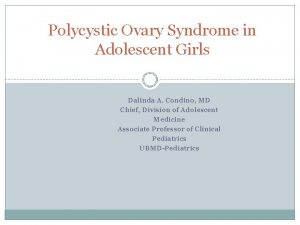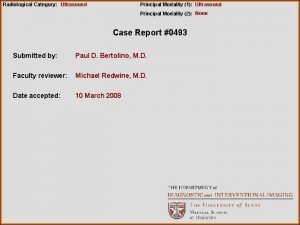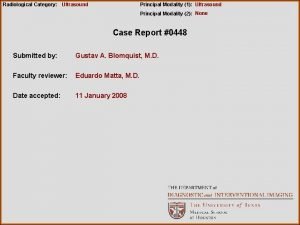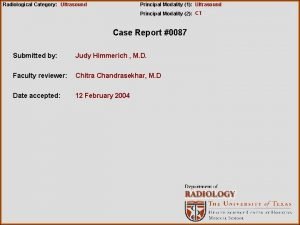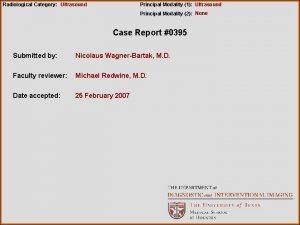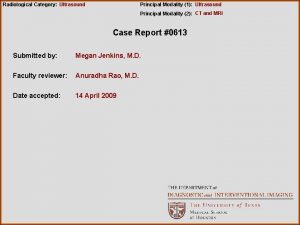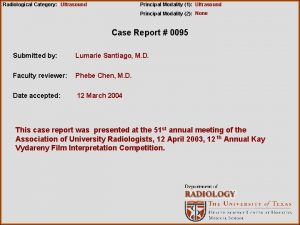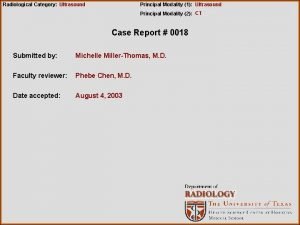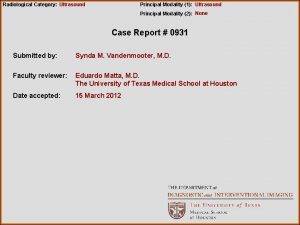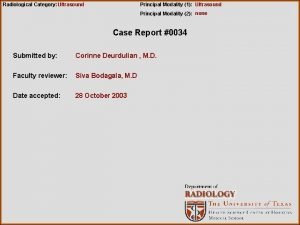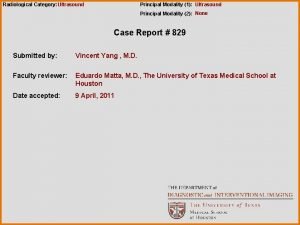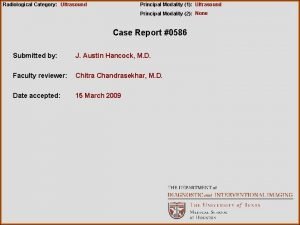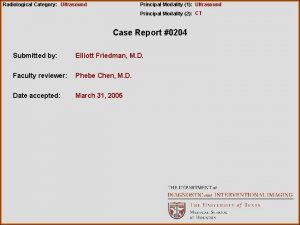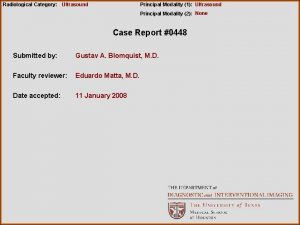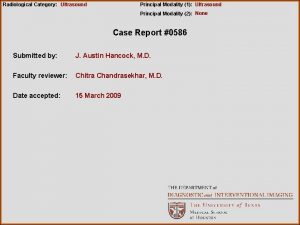Radiological Category Ultrasound Principal Modality 1 Ultrasound Principal


















- Slides: 18

Radiological Category: Ultrasound Principal Modality (1): Ultrasound Principal Modality (2): Computed Tomography Case Report 691 Submitted by: Lee Myers, M. D. Faculty reviewer: Chitra Chandrasekhar , M. D The University of Texas Medical School at Houston Date accepted: 1 March 2010

Case History 25 year old female with pelvic pain and irregular menstrual periods.

Radiological Presentations

Radiological Presentations

Radiological Presentations

Radiological Presentations

Radiological Presentations

Radiological Presentations

Radiological Presentations

Test Your Diagnosis Which one of the following is your choice for the appropriate diagnosis? After your selection, go to next page. • Ruptured ovarian ectopic pregnancy with contralateral corpus luteal cyst • Bilateral hemorrhagic corpus luteal cysts with hemoperitoneum • Bilateral tuboovarian abscesses with frank pus in the pelvis

Additional Images

Additional Images

Additional Images

Findings and Differentials Findings: Sonographic findings: Complex cystic structures within the ovaries bilaterally. Doppler demonstrates “ring of fire” around both of these structures. Complex fluid in the pelvis. No intrauterine pregnancy identified. CT findings: Bilateral ovarian structures with rim enhancement. Fluid in the pelvis measures 30 -40 Hounsfield units. Differentials: • Ruptured ovarian ectopic with contralateral corpus luteal cyst • Bilateral hemorrhagic corpus luteal cysts with hemoperitoneum • Bilateral tuboovarian abscesses with frank pus in the pelvis

Discussion Ectopic pregnancy has increased in incidence from 17, 800 (1970) to more than 70, 000 (1986) and has stabilized since then. However, the death rate has substantially diminished from 3. 6 per 1000 to 0. 5 per 1000. This is likely due to better earlier detection and increased awareness. The classic triad for ectopic pregnancy is irregular menstrual bleeding, pelvic pain, and palpable tender adnexal mass. Ectopic pregnancies are most commonly found in the fallopian tubes with less than 1% involving the ovary. Sonographic features can include the lack of a normal intrauterine pregnancy despite a positive pregnancy test with beta-h. CG >2000, adnexal echogenic mass, pseudosac, and/or complex fluid within the pelvis, which likely represents ruptured ectopic pregnancy. Also, a “ring of fire” around the periphery of the ectopic can usually be identified. A “ring of fire” can also be seen around the corpus luteum.

Discussion The two major causes of complex fluid (yellow arrow) within a young female of child bearing age would be hemoperitoneum or pyoperitoneum. It is difficult to differentiate between these two causes. Differentiating complex ovarian cysts can be difficult as well. Some causes include hemorrhagic cyst, endometrioma, abscess, or ectopic pregnancy. Hemorrhagic cysts have a highly specific sonographic appearance that is useful in pattern recognition in pelvic ultrasound. This appears as a “lace-like pattern” (green arrow), which represents strands of fibrin. However, hemorrhagic cysts can look very different depending on the age of the hemorrhage. Clinical history is important to help differentiate between ectopic pregnancy, tuboovarian abscess, and hemorrhagic cysts.

Diagnosis Bilateral hemorrhagic corpus luteal cysts with a rupture of one of the hemorrhagic cysts causing hemoperitoneum. (Beta-h. CG was negative)

References Middleton, W. D. , Kurtz, A. B. , Hertzberg, B. S. Ultrasound: The Requisites, Second edition. Mosby, Inc. 2004. P. 357 -371.
 Pcos ultrasound image
Pcos ultrasound image Erate category 1
Erate category 1 Radiological dispersal device
Radiological dispersal device Tennessee division of radiological health
Tennessee division of radiological health Center for devices and radiological health
Center for devices and radiological health National radiological emergency preparedness conference
National radiological emergency preparedness conference Modality
Modality High modality definition
High modality definition Modality microsoft services
Modality microsoft services Epistemic modality
Epistemic modality Induction field diathermy
Induction field diathermy Modality stats
Modality stats Sodality vs modality
Sodality vs modality Crow's foot notation
Crow's foot notation Epistemic modality
Epistemic modality Cardinality and modality
Cardinality and modality Cardinality and modality in database
Cardinality and modality in database Entity class in software engineering
Entity class in software engineering Birads
Birads
